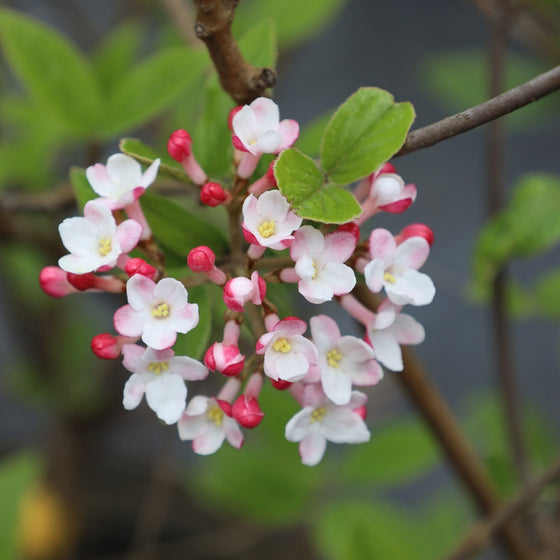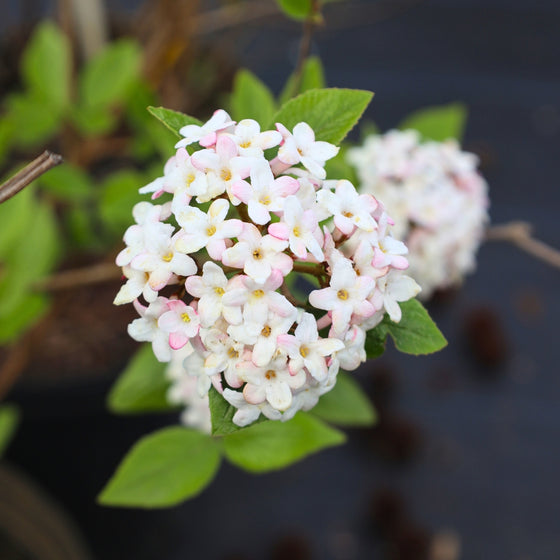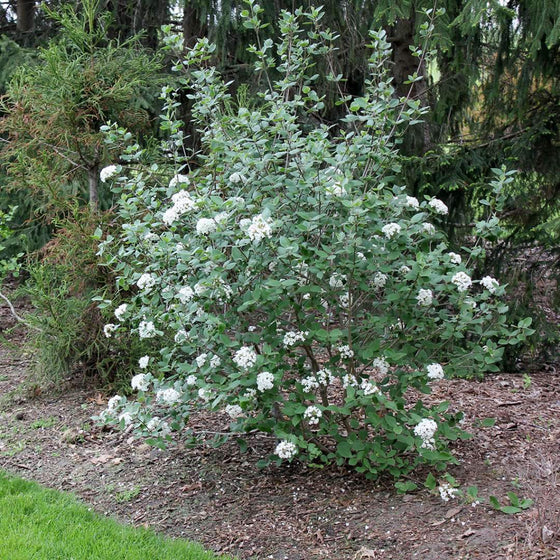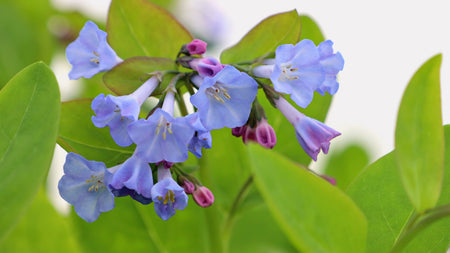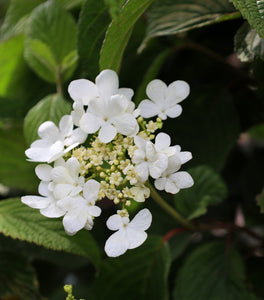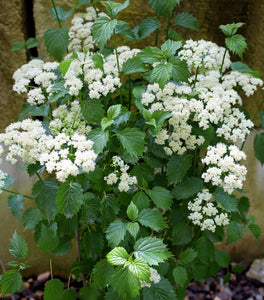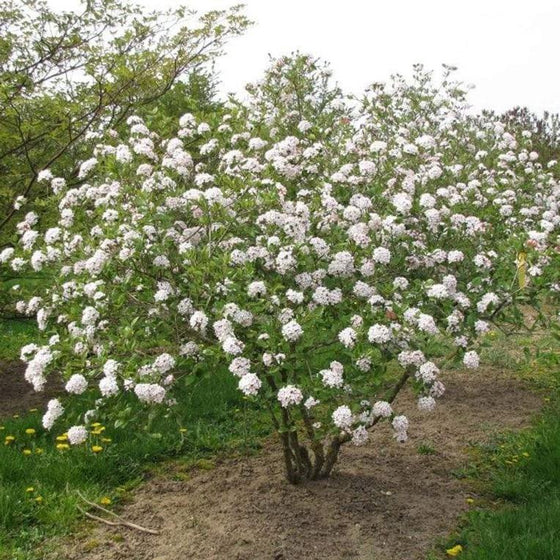
Images Depict Mature Plants
Viburnum Mohawk Shrubs for Sale Online
Viburnum Mohawk (Viburnum x burkwoodii 'Mohawk') is a versatile, semi-evergreen shrub known for its intensely fragrant blooms and vibrant fall foliage. Thriving in USDA Hardiness Zones 4-8, this compact viburnum grows to a mature height of 6-8 feet and spreads 4-6 feet wide, making it perfect for smaller gardens, mixed borders, or foundation plantings. In mid-spring, Viburnum Mohawk bursts into clusters of white flowers that emerge from striking red buds, filling the air with a sweet, spicy scent that attracts pollinators like bees and butterflies.
In addition to its showy flowers, Viburnum Mohawk produces small red berries in late summer, which ripen to black and provide food for birds and other wildlife. Its glossy green leaves create a beautiful backdrop for the flowers and berries, and in the fall, the foliage turns brilliant shades of red and orange, adding stunning seasonal color to your landscape. This shrub is also semi-evergreen, meaning it retains some of its foliage through the winter in milder climates, offering year-round interest.
Low-maintenance and deer-resistant, Viburnum Mohawk is ideal for gardeners looking for a hardy shrub with multi-season appeal. It tolerates a variety of soil types and grows well in full sun to partial shade, making it adaptable to different garden conditions. Whether used as a specimen plant, part of a hedge, or as a wildlife-friendly addition to your garden, Viburnum Mohawk delivers beauty, fragrance, and ecological benefits with minimal care.
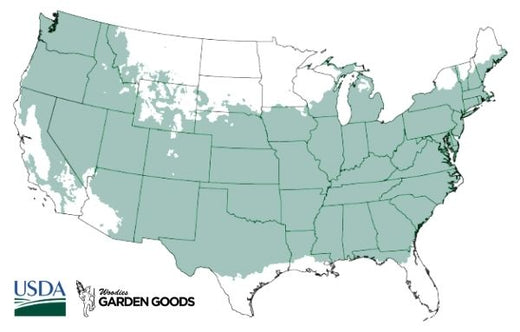
| Hardiness Zone: | 4-8 |
|---|---|
| Mature Height: | 6 to 8 feet |
| Mature Width: | 4 to 6 feet |
| Classification: | Broad leaved semi-evergreen shrub, spring flowering |
| Sunlight: | Full sun to partial shade |
| Habit: | Upright, densely branched |
| Foliage: | Dark green |
| Flower Color: | White, with red on the petal |
| Pruning Season: | Prune in summer after flowering |
| Soil Condition: | Any well drained soil |
| Water Requirements: | Water well until established |
| Uses: | Extremely attractive when used as a focal point in the mixed border, mass planting, or a specimen planting |
How to Care for Viburnum Mohawk
Be sure to read our planting instructions to ensure a healthy and happy Viburnum Mohawk for years to come!
How Do I Plant A Viburnum Mohawk?
To plant a Viburnum Mohawk, start by selecting a location with well-drained soil and full sun to partial shade for optimal growth and flowering. Begin by digging a hole that is twice as wide and as deep as the root ball to give the roots ample space to spread. Place the shrub in the hole, ensuring the top of the root ball is level with the surrounding soil, and then backfill with soil, gently firming it around the roots to eliminate air pockets. After planting, water thoroughly to help the shrub settle in, and apply a 2-3 inch layer of mulch around the base to retain moisture and regulate soil temperature. If you’re planting multiple Viburnum Mohawk shrubs, space them 4-6 feet apart to allow for their mature size. During the first growing season, keep the soil consistently moist by watering deeply once or twice a week, especially during dry periods. Once established, Viburnum Mohawk becomes more drought-tolerant and requires less frequent watering. This low-maintenance shrub is adaptable to various soil types, but it performs best in slightly acidic, well-drained soil. To encourage healthy growth and abundant blooms, apply a balanced, slow-release fertilizer in early spring. With proper planting and care, your Viburnum Mohawk will thrive, offering fragrant blooms in spring, vibrant fall foliage, and wildlife-friendly berries, making it a standout in your landscape.
How Do I Water A Viburnum Mohawk?
To water a Viburnum Mohawk, it is essential to keep the soil consistently moist during the first growing season to help establish a strong root system. Water deeply once or twice a week, ensuring the water reaches the root zone, especially during dry or hot periods. Deep watering encourages the roots to grow downwards, making the plant more drought-tolerant in the future. Mulching around the base of the shrub helps retain moisture, regulate soil temperature, and reduce the need for frequent watering by preventing evaporation. However, be careful not to overwater, as Viburnum Mohawk prefers well-drained soil and waterlogged conditions can lead to root rot. Once established, Viburnum Mohawk becomes more drought-tolerant and will require less frequent watering. During periods of normal rainfall, this viburnum typically does not need supplemental watering, but during extended dry spells or heat waves, check the soil regularly. If the top 1-2 inches are dry, water the shrub thoroughly to maintain its health and promote lush growth. Proper watering ensures that Viburnum Mohawk produces abundant, fragrant blooms in spring, vibrant berries in summer, and stunning fall foliage, making it a resilient and beautiful addition to your landscape.
How Do I Fertilize A Viburnum Mohawk?
To fertilize a Viburnum Mohawk, apply a balanced, slow-release fertilizer in early spring just as new growth begins. A general-purpose fertilizer with a 10-10-10 or 14-14-14 ratio provides essential nutrients like nitrogen, phosphorus, and potassium to promote healthy foliage, strong root development, and abundant blooms. Spread the fertilizer evenly around the base of the shrub, keeping it away from direct contact with the trunk, and water thoroughly after application to help the nutrients absorb into the soil. Fertilizing once a year in spring is typically sufficient to keep Viburnum Mohawk healthy and thriving throughout the growing season. For an organic approach, you can top-dress the soil around Viburnum Mohawk with compost or well-rotted manure in early spring, which enriches the soil and slowly releases nutrients. Avoid over-fertilizing, as too much nitrogen can result in excessive leaf growth at the expense of flowers. Proper fertilization encourages the shrub to produce its signature fragrant white blooms in spring and vibrant red berries in summer, while maintaining healthy, lush foliage. Regular fertilization also supports the striking fall colors of Viburnum Mohawk, enhancing its multi-season appeal in your landscape.

How Do I Prune A Viburnum Mohawk?
To prune a Viburnum Mohawk, the best time is immediately after the shrub finishes flowering in late spring or early summer. Since Viburnum Mohawk blooms on old wood, pruning after the flowers fade ensures you don’t remove the buds for next year’s blooms. Begin by removing any dead, damaged, or diseased branches to improve the plant’s health and appearance. Use sharp, clean pruning shears to make cuts just above a healthy bud or lateral branch. You can also lightly shape the shrub by trimming back any overly long or unruly branches to maintain its natural, rounded form. If your Viburnum Mohawk becomes too dense, thin out some of the older interior branches to improve air circulation and light penetration, which encourages better flowering and overall plant health. Avoid heavy pruning, as this can reduce the number of blooms and berries the following year. Regular light pruning keeps the shrub tidy and enhances its ability to produce fragrant spring blooms and vibrant fall foliage. By following a proper pruning schedule, your Viburnum Mohawk will continue to thrive and remain a stunning feature in your landscape.

